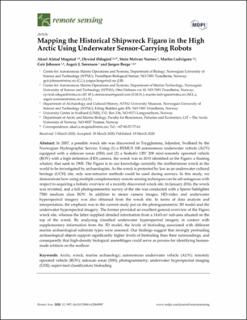| dc.contributor.author | Mogstad, Aksel Alstad | |
| dc.contributor.author | Ødegård, Øyvind | |
| dc.contributor.author | Nornes, Stein Melvær | |
| dc.contributor.author | Ludvigsen, Martin | |
| dc.contributor.author | Johnsen, Geir | |
| dc.contributor.author | Sørensen, Asgeir Johan | |
| dc.contributor.author | Berge, Jørgen | |
| dc.date.accessioned | 2020-03-24T10:21:20Z | |
| dc.date.available | 2020-03-24T10:21:20Z | |
| dc.date.created | 2020-03-23T09:01:26Z | |
| dc.date.issued | 2020 | |
| dc.identifier.citation | Remote Sensing. 2020, 12 (5), . | en_US |
| dc.identifier.issn | 2072-4292 | |
| dc.identifier.uri | https://hdl.handle.net/11250/2648312 | |
| dc.description.abstract | In 2007, a possible wreck site was discovered in Trygghamna, Isfjorden, Svalbard by the Norwegian Hydrographic Service. Using (1) a REMUS 100 autonomous underwater vehicle (AUV) equipped with a sidescan sonar (SSS) and (2) a Seabotix LBV 200 mini-remotely operated vehicle (ROV) with a high-definition (HD) camera, the wreck was in 2015 identified as the Figaro: a floating whalery that sank in 1908. The Figaro is to our knowledge currently the northernmost wreck in the world to be investigated by archaeologists. As the wreck is protected by law as an underwater cultural heritage (UCH) site, only non-intrusive methods could be used during surveys. In this study, we demonstrate how using multiple complementary remote sensing techniques can be advantageous with respect to acquiring a holistic overview of a recently discovered wreck site. In January 2016, the wreck was revisited, and a full photogrammetric survey of the site was conducted with a Sperre Subfighter 7500 medium class ROV. In addition to stereo camera images, HD-video and underwater hyperspectral imagery was also obtained from the wreck site. In terms of data analysis and interpretation, the emphasis was in the current study put on the photogrammetric 3D model and the underwater hyperspectral imagery. The former provided an excellent general overview of the Figaro wreck site, whereas the latter supplied detailed information from a 14.65-m2 sub-area situated on the top of the wreck. By analyzing classified underwater hyperspectral imagery in context with supplementary information from the 3D model, the levels of biofouling associated with different marine archaeological substrate types were assessed. Our findings suggest that strongly protruding archaeological objects support significantly higher levels of biofouling than their surroundings, and consequently that high-density biological assemblages could serve as proxies for identifying human-made artifacts on the seafloor. | en_US |
| dc.language.iso | eng | en_US |
| dc.publisher | MDPI | en_US |
| dc.relation.uri | https://www.mdpi.com/2072-4292/12/6/997 | |
| dc.rights | Navngivelse 4.0 Internasjonal | * |
| dc.rights.uri | http://creativecommons.org/licenses/by/4.0/deed.no | * |
| dc.subject | Arkeologisk fjernmåling | en_US |
| dc.subject | Archaeological remote sensing | en_US |
| dc.subject | Marinbiologi | en_US |
| dc.subject | Marine biology | en_US |
| dc.title | Mapping the Historical Shipwreck Figaro in the High Arctic Using Underwater Sensor-Carrying Robots | en_US |
| dc.type | Peer reviewed | en_US |
| dc.type | Journal article | en_US |
| dc.description.version | publishedVersion | en_US |
| dc.subject.nsi | VDP::Marin teknologi: 580 | en_US |
| dc.subject.nsi | VDP::Marine technology: 580 | en_US |
| dc.source.pagenumber | 24 | en_US |
| dc.source.volume | 12 | en_US |
| dc.source.journal | Remote Sensing | en_US |
| dc.source.issue | 5 | en_US |
| dc.identifier.doi | https://doi.org/10.3390/rs12060997 | |
| dc.identifier.cristin | 1802891 | |
| dc.relation.project | Norges forskningsråd: 245923 | en_US |
| dc.relation.project | Norges forskningsråd: 223254 | en_US |
| dc.description.localcode | © 2020 by the authors. Licensee MDPI, Basel, Switzerland. This article is an open access article distributed under the terms and conditions of the Creative Commons Attribution (CC BY) license (http://creativecommons.org/licenses/by/4.0/). | en_US |
| cristin.ispublished | true | |
| cristin.fulltext | original | |
| cristin.qualitycode | 1 | |

